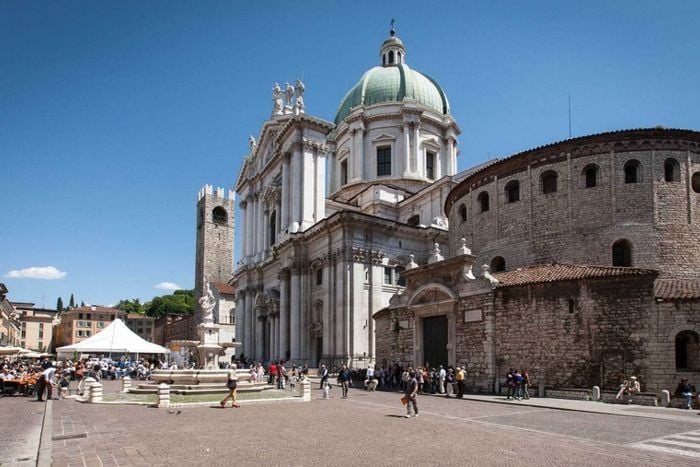
Dominated by Colle Cidneo, with the imposing presence of its castle known as the Falcon of Italy, Brescia hides a very rich heritage of history and art, with testimonials from prehistoric times up to modern ages. Territory of Cenoman Gauls, it became a Roman colony, a Longobard Duchy and then a proud commune until 1426 when it fell under the Venetian Republic. Constituted as an independent republic after its rebellion to Venice, it became member of the Cisalpine Republic, then part of the Lombard-Venetian Reign. The city rebelled against the Austrians during the heroical “ten days” meriting the title of Lioness of Italy.
A long and precious history that can be read through important documents, monuments, ruins and museums that now make Brescia a city of art. To wander through its historical centre is the same as unfolding a book of historical art. Each period of history can still be well seen, starting from Roman Brescia, the ancient Brixia, with the sensational remains of the forum, the Capitolium, the theatre, the Basilica and … the marvellous domus with its rich collection of mosaics. The Benedictine complex of San Salvatore – Santa Giulia, now site of the city’s famous museum, presents us with evidence of the Longobard duchy – King Desiderius and his daughter Ermengard – as sung by Manzoni in Adelchi.
Inside is an extraordinary collection dating from prehistoric times to the present day. In this evocative journey that transports you to the Brescia of 2,300 years ago, you will find yourself walking among ancient Roman houses, Medieval cloisters and over 11,000 works of art.
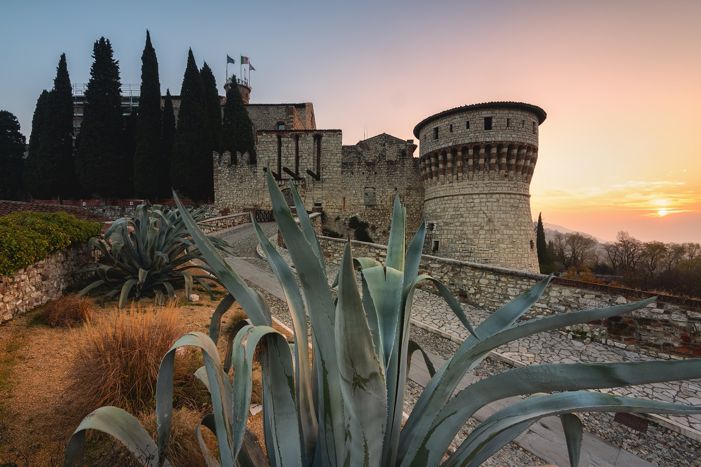
To commemorate the year in which Brescia and Bergamo were chosen as Italy’s Capitals of Culture, for 2023 we have a new section on the Roman era. This up-to-date segment comes in a modern and dynamic format and focuses on Late Antiquity (4th-5th century A.D.). It also features significant finds which, until now, have never been fully displayed. These include several votive artifacts such as jewellery, etched glass, urns and decorated ceramics found during archaeological excavations in the vicinity of the Capitolium.
Not far from the Santa Giulia Museum stands the Capitolium, a jewel in Brescia’s crown. This Roman theatre, built in 73 A.D. by Emperor Vespasian, was reopened in 2013 and is one of the city’s most visited sites. Standing in all its splendour in front of Piazza del Foro, it is built entirely out of Botticino marble. Inside, set amidst the colourful and original marble floors, is the Vittoria Alata, one of the most iconic artistic motifs of the Roman era.
Another one of the city’s most attractive venues is the Tosio Martinengo Art Gallery, which underwent a complete renovation in 2018. Inside are exceptionally beautiful and valuable artworks, including the Angelo by Raphael, L’adorazione dei pastori by Lorenzo Lotto, and, the cornerstone of the collection, works by Brescian Renaissance painters Savoldo, Romanino and Moretto.
Duomo Vecchio and Broletto are poetry in stone testifying the commune period. Renaissance gems are the Loggia and the church of Santa Maria dei Miracoli which saw, in the same years, the flowering of a great school of painters: Foppa, Savoldo, Romanino, Moretto and Gambara are the prestigious names that, competing in ability, enriched so many local churches. For the church dedicated to Saints Nazaro and Celso Tiziano painted one of his early works of art: the Averoldi polyptych.
From the mid-1600s to the mid-1700s Brescia was enriched with some important buildings: the new Duomo with its imposing white Botticino marble façade, Teatro Grande – still a temple of music and prose, and Biblioteca Queriniana – a severe edifice conserving, in its reading room, the original bookcases and decorations with a heritage of more than 300,000 volumes, manuscripts and incunabulums. The following centuries also leave their mark. The 18th century saw the construction of the Mercato dei Grani, Palazzo Tosio and the Music Conservatory. In more modern times, Piazza della Vittoria, designed by architect Marcello Piacentini, was inaugurated in 1932. The square reflects the monumental neoclassic style favoured at that time. Churches, squares and fountains, but also palaces hiding airy courtyards and landscaped gardens, the city offers thousands of treasures to be enjoyed in a path through history and art.
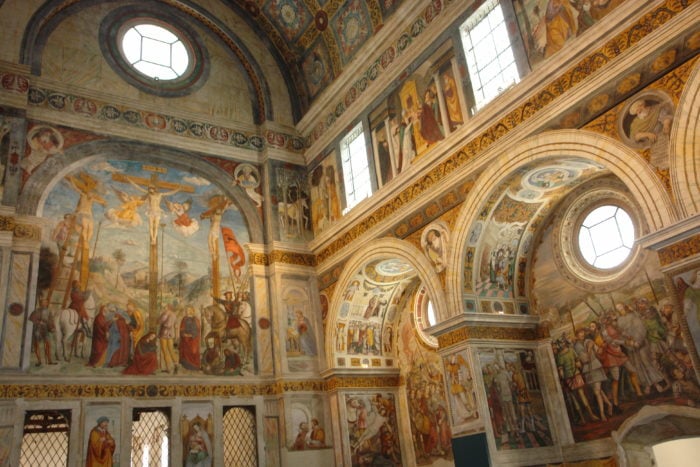
Together with Bergamo, Brescia was chosen as Italy’s Capital of Culture for 2023. This Culture with a capital “C” is the glue that holds together the city’s diversity, a light in the darkness, a new beginning after the wounds left by the pandemic. This is the message conveyed in the slogan “Get out of the bubble”: an invitation to explore new places beyond the beaten path, places that you might not find on the first page of a search engine. The Brescia (and Bergamo) of 2023 is full of surprises thanks to new museums, projects and exhibitions.
Brescia is also one of Italy’s most important economic cities, with an ancient legacy of craftsmanship, industry and commerce. The precious craftsmanship involved in the production of weapons can be admired in the collections on show at the “Marzoli” – one of the largest in Europe in terms of historic armaments and armour, housed at the castle. Within the castle walls you’ll also find a museum on the Risorgimento, recently reopened following its renovation. Ancient Arms Museum housed in the castle – one of the largest in Europe in terms of historic armaments and armour, housed at the castle. Within the castle walls you’ll also find a museum on the Risorgimento, recently reopened following its renovation.
Brescia is an easy place to visit, with tourists now able to access its major attractions thanks to its metro, opened in 2013.
Proud home of the Mille Miglia, every year the city basks in the glory days of this famous motor race, serving as the starting grid and finish line for the finest vintage cars in the world. Motorheads can relive this legendary event at the Mille Miglia Museum, housed in the beautiful monastery dedicated to Saint Euphemia. The city hosts numerous shows and events, both in the arts and sports.
There are also opportunities to experience nature. Ten minutes from the city centre are gorgeous walks to the Ronchi, on Maddalena Hill, through woods, meadows, orchards and allotments.
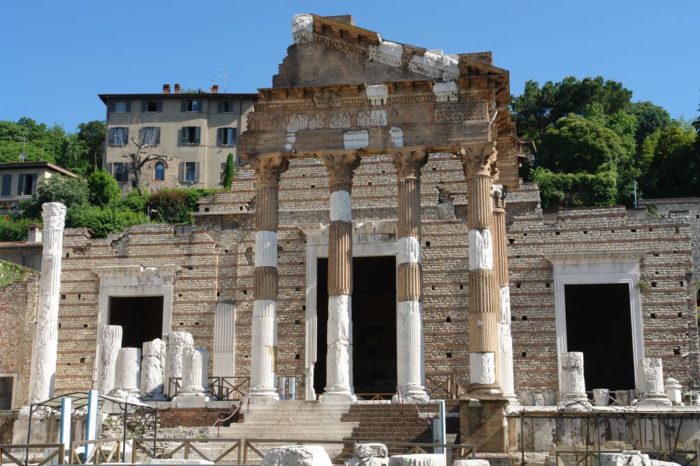
The city itself doesn’t have much of its own traditional cuisine. In restaurants, you’ll find dishes from all of the broader region. The most common first courses are casoncelli pasta stuffed with the classic parmesan, meat, breadcrumbs and egg, or with ricotta. The pasta is boiled and served with melted butter, sage and Grana Padano. Second courses include Brescia’s most iconic dish: spit-roasted beef and goat with polenta.
It’s the job of the traditional sweet treats to represent the city. The sweet par excellence is the persicata, made with Collebeato peaches, picked at the end of the season due to the distinctive consistency of their pulp at this time. Sold in the best patisseries in beautifully packaged, small, sugar-coated pieces, they also make a great gift or culinary souvenir to bring back from the Brescia province. Brescia’s other traditional sweet is the bossolà – a delicious Christmas treat made with an equal amount of butter, sugar and egg yolk. Finally, there are Brescia’s very own spaccadenti biscuits (literally meaning “tooth-breakers” owing to their hard consistency) made with sugar, white flour and olive oil.
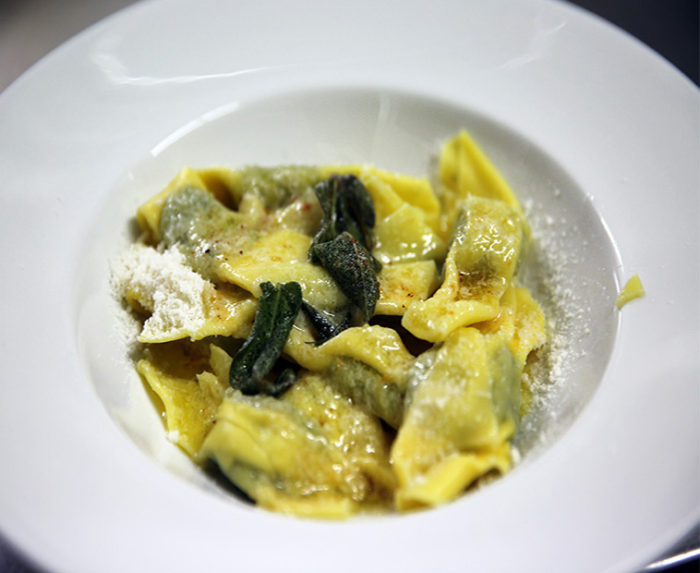
You can take in a magnificent view of rooftops, bell towers, domes, and towers in the view that extends all the way to the Ronchi. In days gone by, the Ronchi served as the city’s kitchen garden, providing fruits and vegetables for all of Brescia’s residents. The trattorias and local taverns known as licinsì are less common now, but tradition still lives on with a fresh focus on quality. Livestock rearing and dairy farming are alive and well in the area, with organic goat cheeses being produced in Val Persane in the Mompiano area. Heading towards Valle Trompia and Valle Sabbia, the city dissolves into Brescia’s tree-covered Parco delle Colline, where you can follow the marked paths to discover the area’s plant life.
At the entrance to the city, Collebeato peach orchards are flourishing once again. These were the heart of the local economy in the 19th century, together with the vineyards. The tradition dates to 1911, when Sir Filippo Rovetta initiated the planting of a model peach orchard, containing a variety of Canadian peaches.
Peaches are now making a comeback, and even have their very own festival every July. Peschello, a peach liqueur, is a relatively new invention. Persicata, on the other hand, is a solid conserve that has been made from this luscious Collebeato peach for a very long time. Along with bossolà, it is a quintessential delicacy of Brescia. Collebeato is also known for growing a variety of camellia flowers known as Madonna della Calvarola, dedicated to the Virgin of Collebeato, whose renaissance-style shrine stands on the slopes of St. Stefano Hill.
Heading a few kilometres towards Lake Garda, you’ll come across Botticino and its Marble Museum that is the starting point for the intriguing Via del Marmo itinerary. The walk consists of three routes that weave their way through the towns of Virle, Nuvolera, Nuvolento, Prevalle, Gavardo Rezzato and Serle. On this idyllic and symbolic journey, you will encounter mines, remains of industrial archaeological artifacts and architectural features that tell of the toil and creativity of the stonemasons and craftsmen. These artisans left their ingenious mark on numerous town and country churches, as well famous sites such as Rome’s Altar of the Fatherland, made from Botticino marble.
From Botticino, you can head up to San Gallo – home to Eremo della Trinità and a prestigious restoration training school – to arrive at the Serle hills in Valle Sabbia. Here, in the autumn, the best trattorias serve game and mushroom-based specialties with DOC Botticino, a wine that comes from these rocky hills.
At the entrance to the Valverde stands Rezzato, where you’ll encounter several splendid historic civil and religious buildings. This includes the Santuario di Valverde, where you can observe a much-loved religious procession on the last Sunday of July. The municipal building and parish church testify to the skill of the Rezzato marble-workers. Rezzato is home to the spectacular 18th-century Avogadro Fenaroli Villa and the Pinacoteca Internazionale dell’Età Evolutiva Aldo Cibaldi, where you can enjoy workshops and art pieces created by children from across the world in the last 50 years.